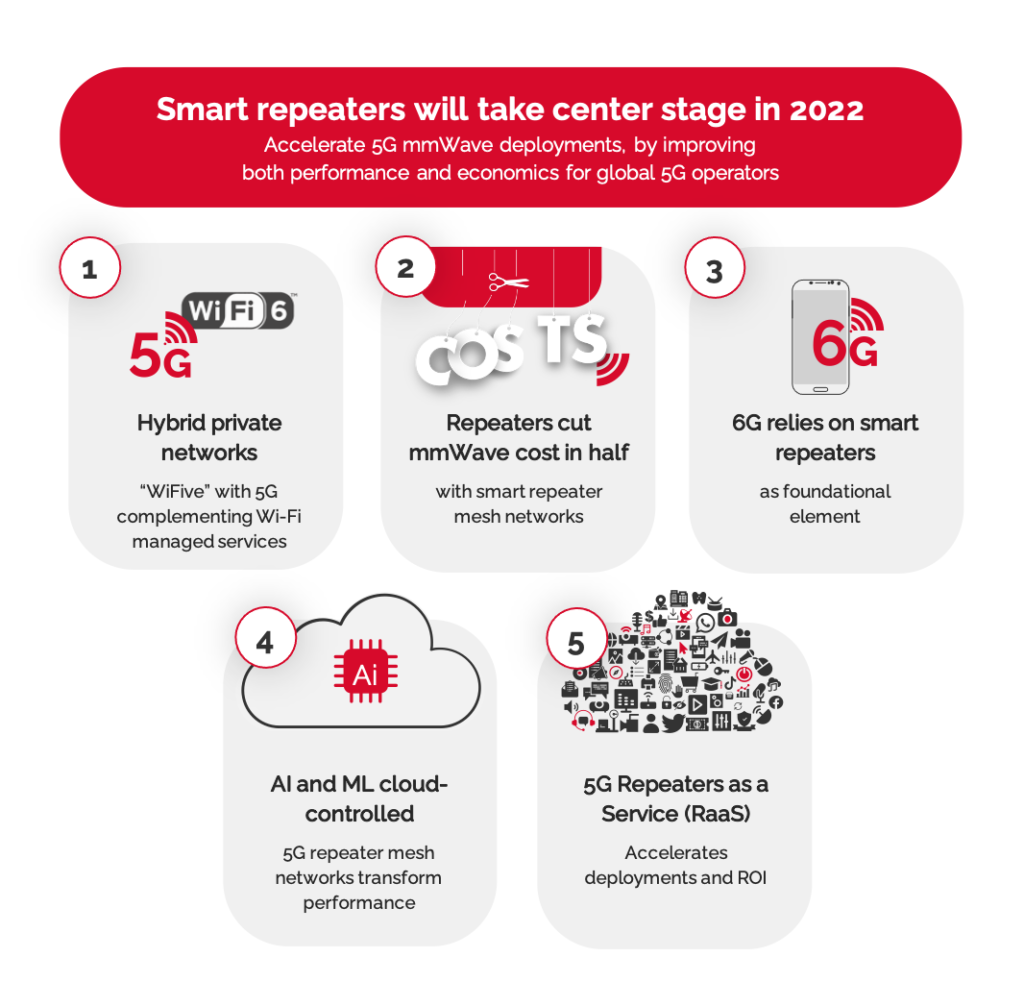It’s been a tumultuous year for 5G as wireless carriers scrambled to deploy their networks at mid-band and increasingly millimeter-wave frequencies, and the trend will undoubtedly accelerate in 2022. So, with this in mind, we are making some projections about what we believe will be the 5G “megatrends” in the coming year. In general, they focus on the virtual certainty that 5G mmWave networks will be more widely deployed, driven in large measure by solutions such as Movandi’s cloud-and-AI-based mesh network technology that eliminates the challenges of line-of-site signal propagation.
Most important, 2022 is the year smart repeaters will take center stage to help accelerate challenging 5G mmWave deployments, by improving both performance and economics for global 5G operators. Here we go:
- New hybrid private networks and managed service offers using both Wi-Fi and 5G millimeter-wave technologies, or “WiFive”, gain momentum as a high-performance, flexible and economic solution for enterprises.
Although it might not appear so at first glance, Wi-Fi and mmWave systems are complementary, and there are big benefits when they are. Wi-Fi is ubiquitous, with an installed base of at least 22 billion devices1, all of which are ultimately connected to Ethernet infrastructure. But Wi-Fi networks must support a large number of distributed access points and the fiber backbone connectivity can be expensive.
Millimeter-wave networks can be used for “wireless fiber” operating in the unlicensed 60 GHz and licensed 24/28/39 GHz spectrum to replace expensive fiber for backhaul while also providing broader coverage in the fronthaul, especially in large buildings, stadiums, and shopping environments. Together, this hybrid “WiFive” approach brings the unique characteristics and massive available bandwidth of millimeter-wave frequencies together with the huge installed base of Wi-Fi devices to allow gigabit speeds and lower latency to be achieved at very low cost. In addition, new managed service providers will emerge with a WiFive Network as a Service model designing, implementing, and operating these hybrid networks.
- Intelligent mmWave repeater-based mesh networks leapfrog current approaches making broad deployment cost-effective for the first time.
The conventional approach for deploying mmWave technology relies on placing gNBs or small cells globally will be least $400 billion by 20302, which is obviously not cost-effective. Movandi’s approach turns this paradigm on its head by reinventing the network architecture, dramatically reducing the number of gNBs, small cells, and optical fiber required to serve customers indoors and outdoors. In a white paper3, the highly respected analyst firm Mobile Experts estimates that smart repeaters will cut deployment costs and time in half. Reza Rofougaran, Movandi CTO and co-founder with over 1,000 RF patents, suggests there will be a ratio of between 4:1 to 10:1 smart repeaters to gNB/small cells depending on the application and coverage requirements. As a result, we expect this repeater-based mesh approach to become the standard way that millimeter-wave frequencies are utilized, with the first large commercial deployments in 2022.
- AI, ML and cloud-based orchestration for dynamic real-time optimization will become essential enablers for 5G mmWave networks and C-V2X mobility.
Millimeter-wave network performance, reliability, and economics can be optimized with real-time cloud and AI-controlled mesh networking. Traffic is dynamically routed based on changing usage patterns and rapidly varying signal conditions. Machine learning assesses environmental conditions with continuous updates for things such as a moving van, new building or foliage growth and predicts the best coverage models and for moving vehicles, and the best gNB signals and beams. In addition, automated signal search and detection allows installation locations to be optimized while dramatically reducing the time and cost for deployment because they are comparatively simple to construct in a “plug-and-play” fashion, eliminating the need for technicians and installers to have a high level of expertise.
- 6G network foundation will rely on the new 5G repeater network innovations.
While 5G is arguably the most wide-ranging 3GPP innovation since the inception of cellular technology, 6G presents even more daunting MmWave challenges that have only recently begun to be addressed. However, solutions such as the Movandi smart repeater have already solved the problems associated with millimeter-wave coverage, economics and operation. As they become widely deployed throughout this decade, they will provide an infrastructure foundation and valuable insight for the migration to 6G networks that will operate at frequencies greater than 100 GHz, where no wireless communications systems have operated before.
- 5G Repeater as a Service (RaaS) will transform operator investment strategies and accelerate network deployment.
The modular 5RaaS model will enable service providers to select only the services they need and increase deployment speed by reducing up-front capital investment and the cost of keeping technology and cloud AI software up to date. It will include intelligent repeater hardware, chipsets, highly advanced antenna technology and cloud AI software services, which are constantly being enhanced and updated as environmental conditions change. New open APIs will provide the flexibility to allow developers to create services that can be packaged as complete solutions tailored to allow customers to select only the services they need. It will be essential in the coming year for standards bodies to allow these services to proliferate unencumbered by restrictions posed by proprietary hardware and software.
Now that we’ve made our projections, only time will tell how accurate they are, so at this time next year we will take a look back at how close we were to the mark.
References
- “Number of wireless local area network (WLAN) connected devices worldwide from 2016 to 2021”, Statista, https://www.statista.com/statistics/802706/world-wlan-connected-device/
- Connected world: An evolution in connectivity beyond the 5G revolution”, page v, McKinsey Global Institute, https://www.mckinsey.com/~/media/mckinsey/industries/technology%20media%20and%20telecommunications/telecommunications/our%20insights/connected%20world%20an%20evolution%20in%20connectivity%20beyond%20the%205g%20revolution/mgi_connected-world_discussion-paper_february-2020.ashx
- “5G mmWave Repeaters Cut Costs in Half,” Mobile Experts,” https://mobile-experts.net/reports/p/white-paper-semiconductors-for-oran-ss6db








